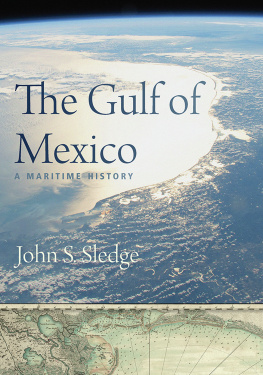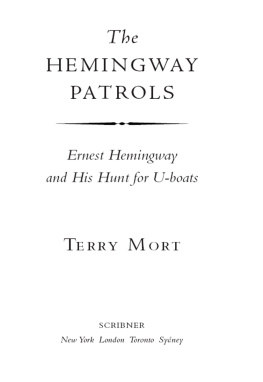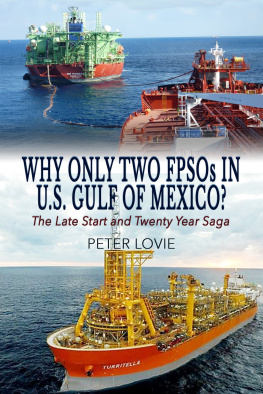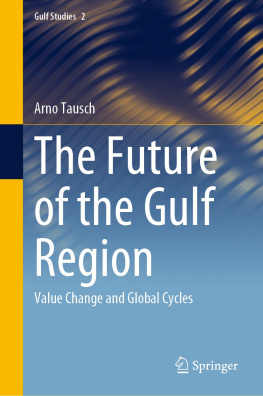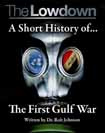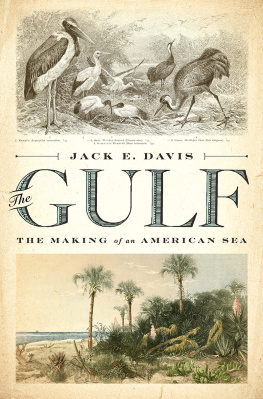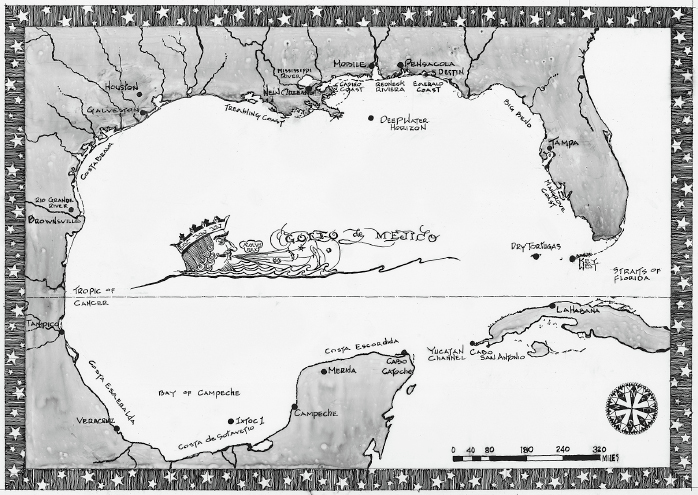
The Gulf of Mexico
The Gulf of Mexico by Nicholas Holmes III, 2017.
The Gulf of Mexico
A Maritime History
John S. Sledge

2019 University of South Carolina
The Gulf of Mexico map by Nicholas H. Holmes III 2017
Published by the University of South Carolina Press
Columbia, South Carolina 29208
www.sc.edu/uscpress
28 27 26 25 24 23 22 21 20 19
10 9 8 7 6 5 4 3 2 1
Library of Congress Cataloging-in-Publication Data
can be found at http://catalog.loc.gov/.
ISBN 978-1-64336-014-0 (cloth)
ISBN 978-1-64336-015-7 (ebook)
Publication of this book was made possible through the generosity of the A. S. Mitchell Foundation, Mobile, Alabama.
FRONT COVER ILLUSTRATIONS: (top) the Gulf coast photographed by crew member of Expedition 58 of the International Space Station, 2019; (bottom) Carte dune partie des ctes de la Floride et de la Louisiane , 1778, courtesy of the Library of Congress
In memory of my cousins:
Mack Clarke, who fell off a shrimp boat and drowned in the Gulf, 1986
Terry Clarke, who died of a heart attack during Hurricane Georges, 1998
Shadows lengthen; and at last the woods dwindle behind you into thin bluish lines;land and water alike take more luminous color;lakes link themselves with sea-bays;and the ocean-wind bursts upon you,keen, cool, and full of light.
Lafcadio Hearn,
Chita, 1889
Contents
Illustrations
following page 86
following page 146
Acknowledgments
First, my profoundest thanks go to Joseph Meaher and the trustees of the A. S. Mitchell Foundation, whose generous support made this book possible. When I told Capn Joe that I wanted to write a maritime history of the Gulf, he immediately asked how the Foundation could help further the project. He also asked if I planned to cover Cabeza de Vacas epic odyssey along our shores, and I assured him that I did!
I am grateful as well to the many people who expressed their sincere interest during my research phase and shared their rich tidbits of Gulf lore. Jody Kamins Harper made available her extensive interviews with family member Charlie Bodden, whom she had the foresight to record as he recalled working some of the Gulfs last lumber schooners. Retired Orange Beach charter boat captain Earl Callaway graciously spent an entire day taking me around the Alabama shore and regaling me with the most wonderful stories. He is a man of parts. Former Destin History and Fishing Museum executive director Kathy Marler Blue provided valuable insight into charter fishings early days, and John Ray Nelson of Bon Secour Fisheries told me about his century-plus-old company and life on board Mobile Bay sailing luggers. John Dindo showed me around the Dauphin Island Sea Lab, and his wife, Charlene Dindo, thoughtfully gave a copy of my earlier book on the Mobile River to the legendary naturalist E. O. Wilson, who knows the central Gulf Coast well. I am also indebted to Greg Anderson, Dave Berault, Jack E. Davis, Hardy Jackson, Mike Feore, Watt Key, John Hunter, David Smithweck, Jim Delgado, Ken Cooper, Margaret Long, and Michael Shipler for much good information. Lincoln Paines thoughts on maritime history in general and its pursuit as a field of study helped me stay focused during many long months of composition.
Among the individuals and institutions to which I am indebted are retired director Greg Waselkov, Bonnie Gums, and Sarah Mattics of the Center for Archaeological Studies, University of South Alabama; past director Tony Zodrow and former chair E. B. Peebles III at GulfQuest National Maritime Museum of the Gulf of Mexico; Amy Raley, education manager at GulfQuest; Jocko Potts, Stephen Potts, Anita Miller, Maggie Lacey, Lawren Largue, Chelsea (Capability) Adams, and Breck Pappas of Mobile Bay magazine; director Jimmy Lyons, Judy Adams, harbormaster Terry Gilbreath, and Maria Conchita Mendez at the Alabama Port Authority; Kelly Barfoot at the Mobile Bay National Estuarine Program; Mike Bunn at Blakeley State Park; Gail Walker Graham at the Orange Beach Indian and Sea Museum; Siva Blake at the Civil District Court, Orleans Parish; Germaine Bienvenu, LSU Libraries; Rebecca Smith, Historic New Orleans Collection; Katie Barry at the Stark Museum of Art in Orange, Texas; Barbara Howard at the Harte Research Institute for Gulf of Mexico Studies in Corpus Christie; Julio Larramendi, Honors College, University of Alabama; Melinda Rose, photographer; Michael Mastro, photographer; Tina McDowell at the Carnegie Institution of Science in Washington, D.C.; and Emerson Hunton and John Powell at the Newberry Library, Chicago. All of these wonderful people took time out of their busy schedules to help me on my way. If I can ever return the favor, I certainly will.
As always, I hold my friends dear. Eugene LeVert was a wonderful sounding board on nautical matters. Scotty Kirkland was never too busy to discuss the finer points of reading and writing history. Nick Beeson was a rock, obtaining highresolution photographs from a dozen sources and remaining good-humored throughout what must have been far too many intrusions. Grey Redditt Jr. was always ready to talk about Havana, David and Simona Newell took my wife, Lynn, and me on several unforgettable trips up coastal rivers, across choppy bays, and even out onto the heaving Gulf itself on board their handsome Stauter-Built boat, Roy Hoffman never failed with sage literary advice, Nick Holmes III happily agreed to draw the very fine Gulf of Mexico map to go with this book, and his secretary, Margaret Davis, helped facilitate.
I feel fortunate indeed to have a publishing home with the University of South Carolina Press. Former director Jonathan Haupt pounced on this book the minute I inquired, and incoming director Richard Brown was equally enthusiastic. A writer doesnt get that every day. Assistant Director for Operations Linda Haines Fogle (recently retired) and Marketing and Sales Director Suzanne Axland were always generous with their time and never failed to make me laugh. Their professionalism is exceeded only by their good cheer. I am also grateful for the anonymous readers close attention to the manuscript.
Lastly, my family has been terrific. My mother, Jeanne Sledge, read the manuscript as I wrote each chapter and offered encouragement as well as suggested improvements. Lynn edited it with her usual nuance and care, while our children, Matthew and Elena, both grown and living in Birmingham, were admirably patient with a father who was often preoccupied by the past. My younger brother, Henry, his wife, Andrea, and their son, Jack, all love the Gulf and go there frequently, and their early enthusiasm was much appreciated. It should go without saying, but I will say it, nonethelessany errors of fact found herein are to be laid solely at my door.
Prologue
Small Craft Advisory
O ur first view of Destin, Florida, came as we raced east across the bridge from Okaloosa Island. The year was 1974, and there wasnt much to the town thena few high-rise condos, some scattered beach houses, a thinly developed harbor, and about three thousand residents plopped down amid some of the most gorgeous scenery on the entire northern Gulf Coast. The occasion was our annual family vacation. We lived in a little college town called Montevallo, just south of Birmingham, Alabama, where Dad had taught biology since 1962 and Mom was a homemaker. Despite our inland address, we proudly owned deep coastal roots. Dad was a native Mobilian, Mom had spent part of her childhood in New Orleanss famed Pontalba Building, and I was born in Gainesville, where Dad attended the University of Florida before working a stint at a Winter Haven plant nursery and then moving us north. Given this family history, as well as the Florida Panhandles abundant distractions and drivable distance from home, we regularly vacationed there during the 1970s, though usually farther east at Panama City Beach. Why we chose Destin during this particular year I dont recall, but neither I, at seventeen, nor my brother Henry, ten, complained. We had a close relationship with our parents, and it was good to get away together.
Next page
